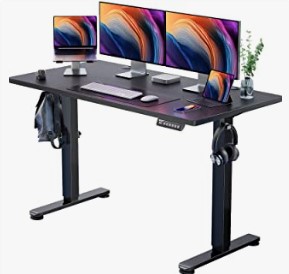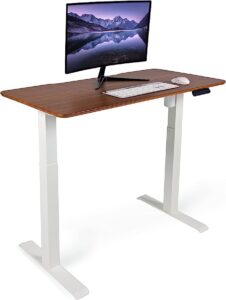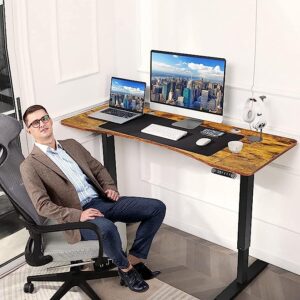Why Use Adjustable Standing Desks?
Have you ever wondered why so many people choose to use adjustable standing desks?

Would you like to know the reasons behind this increasingly popular trend? In this article, we will explore the benefits of using an adjustable standing desk and how it can improve your health and well-being.
Reduces Sedentary Lifestyle: In a world where we spend a lot of our time sitting, using an adjustable standing desk can be the ideal solution to reduce sedentary lifestyle. While it is true that sitting for long periods can increase the risk of cardiovascular diseases, diabetes, and obesity, standing can be an excellent alternative to improve our health. Additionally, when we stand, our body burns more calories than when we sit, which helps maintain a healthy weight.
Improves Posture: Using an adjustable standing desk can also help improve posture. When standing, our body tends to stay more upright, which in turn helps align the spine and reduce pressure on the joints. This can be especially beneficial for those who suffer from back or neck pains related to poor posture.
Increases Productivity: Another benefit of using an adjustable standing desk is that it can improve productivity. When standing, our brain receives more oxygen, which in turn helps increase concentration and energy. Additionally, many users have reported that standing has helped them stay more alert and focused during long hours of work.
Reduces Stress: Standing can also help reduce stress. When we sit, our body tends to relax, and it can be easy to fall into a slouched posture that increases muscle tension. When standing, our body is more active, which in turn can reduce stress and anxiety.
Customizable for Your Needs: An adjustable standing desk can be customized for your individual needs. You can adjust the height to fit your height, as well as for different tasks, such as writing, reading, or working on a computer. This allows you to find the most comfortable and ergonomic position for you, which can help reduce muscle pain and fatigue.
Versatility: An adjustable standing desk is versatile and can be used in different environments. If you work from home, it can be an excellent option to create a healthy and productive workspace. If you work in an office, you can use it to break the routine of sitting all day and improve your health.
Variety of Styles: Adjustable standing desks are available in a wide variety of styles and designs to suit any taste and need. From electric to manual standing desks, there is an option for every budget and style preference.
Conclusion: In summary, using an adjustable standing desk can be a great option to improve your overall health and well-being. From reducing sedentary lifestyle and improving posture to increasing productivity and reducing stress, the benefits are numerous. Additionally, an adjustable standing desk can be customized for your individual needs and adapts to different environments, from home to office.
If you are looking to improve your health and well-being while working or studying, an adjustable standing desk can be the perfect solution. Consider investing in one to experience the benefits in your daily life.
Some Statistical Facts.
Can an Adjustable Standing Desk Be Bad?
It’s no secret that sitting for long hours at your desk can be harmful to your health. Recent research has shown that sitting for prolonged periods of time increases the risk of heart disease, obesity, cancer, and other health problems. Even if you exercise a lot outside of work, the negative effects of sitting for hours cannot be easily eliminated.
That’s why standing desks are the fastest-growing employee benefit in US workplaces, according to a report by the Society for Human Resource Management. This type of desk allows you to stand while working on your computer, which can have significant health benefits.
Some companies selling standing desks claim that they provide health benefits, including weight loss, decreased back pain, mental health benefits, decreased blood sugar, cholesterol reduction, and increased life expectancy. While some of these benefits have not yet been conclusively proven, there is evidence that standing while working can improve your health in various ways.
For example, a study published in the Journal of Physical Activity and Health found that standing burns around 88 calories per hour, compared to the 80 calories burned while sitting. While this amount may seem small, if multiplied by several hours a day and several days a week, it can make a big difference in terms of weight loss and health improvement.
In addition, standing can improve posture and reduce the back and neck pain often associated with sitting for hours. It can also help improve circulation and reduce fatigue and stress.
Of course, not everyone feels comfortable working while standing for long periods of time. Some people may experience leg, foot, or back pain if they stand for too long. That’s why experts recommend starting slowly, standing for only 30 minutes to an hour a day, and then gradually increasing the time as you feel more comfortable.
Fortunately, standing desks come in a variety of options to fit your needs and budget. You can start with something as simple as raising your computer monitor with a box or stack of books, or you can invest in an adjustable platform that fits your height by pressing a button. Prices can range from a few hundred dollars to over a thousand, depending on the quality and functionality of the desk.
So, what can we conclude about standing desks? While there is no definitive evidence that using a standing desk has all the benefits attributed to it, it does seem clear that sitting for long periods of time is harmful to health and that taking frequent breaks to walk and change posture can help counteract these risks. If you want to try a standing desk, it’s important to do so gradually and keep in mind that it’s not the magic solution to good health. Combined with a healthy diet and active lifestyle, it can be a healthier way to work.
References:
Pronk, N. P., Katz, A. S., & Lowry, M. (2012). Reducing occupational sitting time and improving worker health: the Take-a-Stand Project, 2011. Preventing chronic disease, 9, E154. Hedge, A., & Ray, R. (2004). Effects of an adjustable ergonomic workstation on postural variation in computer users and observers. Work, 23(2), 107-116. Healy, G. N., Eakin, E. G., Lamontagne, A. D., Owen, N., Winkler, E. A., & Wiesner, G. (2015). Reducing sitting time in office workers: short-term efficacy of a multicomponent intervention. Preventive medicine, 73, 111-116. Thorp, A. A., Owen, N., Neuhaus, M., & Dunstan, D. W. (2011). Sedentary behaviors and subsequent health outcomes in adults: a systematic review of longitudinal studies, 1996–2011. American journal of preventive medicine, 41(2), 207-215. Straker, L., Levine, J., & Campbell, A. (2009). The effects of walking and cycling computer workstations on keyboard and mouse performance. Human Factors: The Journal of the Human Factors and Ergonomics Society, 51(6), 831-844. Karasek, R. A., & Theorell, T. (1990). Healthy work: stress, productivity, and the reconstruction of working life. Basic Books. Callaghan, J. P., & McGill, S. M. (2001). Intervertebral disc herniation: studies on a porcine model exposed to highly repetitive flexion/extension motion with compressive force. Clinical biomechanics, 16(1), 28-37.»









